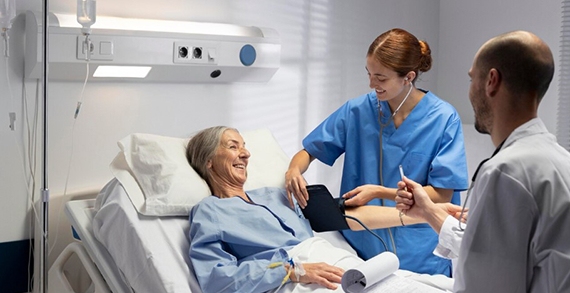
Reform e-ICU stands as the epitome of critical care. With its diverse team of critical care experts, Reform stands out in a field where there is a severe lack of trained professionals, guaranteeing that patients receive unmatched treatment. The staff is prepared to serve patients around the nation because they are not only varied but also well-versed in their fields. The goal of Reform e-ICU is to increase the capacity of medical professionals to treat and save more lives by constructing state-of-the-art critical care team-equipped facilities throughout India. Reform offers not only medical care but also a team of highly skilled and diverse professionals that are revolutionizing critical care for the benefit of humanity.
To solve complex medical conditions, the Reform e-ICU team of multi-talented doctors works together seamlessly throughout each shift. With a multidisciplinary background that includes infectious disease, pulmonology, anesthesia, and internal medicine, the highly skilled intensivist team combines their many skills to examine complex cases and provide precise diagnoses. Reform e-ICU facilitates this holistic approach, which leverages a plethora of knowledge to ensure thorough analysis and efficient decision-making. Their combined knowledge transcends regional boundaries to provide patients with excellent critical care, making them a ray of hope.

It improves the productivity of current employees while addressing the crisis faced by critical care professionals.
Super-specialties backup coverage is available 24/7.
overcoming geographic obstacles to receive professional medical care.
lowering judgment errors brought on by stress at work or a lack of qualifications.
Improved awareness and partner reputation.
utilizing current practices, processes, and infrastructure.
e-ICU, or "electronic intensive care unit," is a cutting-edge healthcare model that leverages telemedicine to enhance patient care in intensive care units (ICUs). This system connects ICU patients with off-site critical care specialists through advanced digital platforms, allowing for continuous monitoring and real-time decision-making. e-ICUs utilize high-definition cameras, sophisticated sensors, and data analytics to transmit vital patient information—such as heart rate, blood pressure, oxygen levels, and more—back to a remote team of intensivists, nurses, and respiratory therapists. These experts can assess patients, detect early signs of deterioration, and provide immediate interventions, even if they are miles away from the physical ICU.
The primary benefit of e-ICUs is the ability to extend the reach of skilled intensivists to multiple hospitals, especially in rural or underserved areas where access to specialized care may be limited. By offering constant monitoring and support, e-ICUs have been shown to reduce patient mortality, length of stay, and healthcare costs. Moreover, they can improve workflow efficiency in hospitals, enabling on-site ICU staff to focus on critical hands-on care while the remote team oversees overall patient management. Despite challenges, such as the need for robust infrastructure and data security, e-ICUs represent a transformative approach to intensive care, improving both patient outcomes and healthcare accessibility across diverse regions.
e-ICUs have revolutionized the way critical care is delivered by providing continuous, 24/7 monitoring of patients in intensive care units, often in remote or under-resourced areas. Through the use of high-tech tools such as remote cameras, sensors, and sophisticated data analytics, e-ICUs enable real-time communication between on-site clinical staff and off-site intensivists, ensuring prompt response to any changes in patient condition. This remote model not only supports better clinical decision-making but also addresses staffing shortages, especially in rural or smaller hospitals, by enabling experienced specialists to manage multiple ICUs at once. Additionally, the use of e-ICUs has shown promising results in reducing hospital readmissions, preventing adverse events, and improving patient safety, all while lowering healthcare costs. The system's ability to monitor trends in patient health and quickly intervene when necessary can prevent complications before they become life-threatening. However, e-ICUs do require a significant investment in technology, training, and secure data management, as well as ensuring seamless integration into existing hospital systems. Despite these challenges, the overall impact of e-ICUs on enhancing care delivery and outcomes remains significant, representing a vital tool in the future of healthcare, particularly in a world increasingly reliant on telemedicine solutions.